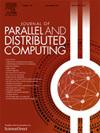SEDViN:使用多属性匹配游戏安全嵌入动态虚拟网络请求
IF 4
3区 计算机科学
Q1 COMPUTER SCIENCE, THEORY & METHODS
引用次数: 0
摘要
网络虚拟化(NV)由于允许服务提供商(SP)共享基板网络(SN)资源而受到广泛关注。这是通过将它们划分为相互隔离的虚拟网络请求(vnr)来实现的,这些请求由相互关联的虚拟机(vm)和虚拟链路(VLs)组成。NV虽然具有业务分离、增强服务质量、提高可靠性、提高SN利用率等诸多优点,但在科学上也面临着诸多挑战。在这种背景下,研究人员遇到的一个关键挑战是安全虚拟网络嵌入(SVNE)。SVNE包括将SN资源分配给VNR的组件,即vm和vl,以满足安全需求,这是一个计算上难以解决的问题,被证明是NP-Hard。在这种情况下,最大限度地提高接受度和收入成本比仍然是服务提供商的首要任务,因为这不仅可以增加收入,还可以有效地利用大量的网络资源池。虽然VNE是一个研究得很好的问题,但现有文献存在以下缺陷:(1)忽略虚拟机和虚拟机的安全特性;(2)对拓扑属性的考虑有限;(3)局限于静态虚拟机网络。然而,sp需要开发一个克服上述缺陷的嵌入框架。因此,本文提出了一种基于多属性匹配博弈(SEDViN)的动态虚拟网络请求安全嵌入框架。在SedViN中,采用基于延迟接受算法(DAA)的匹配游戏进行有效嵌入。SEDViN主要分两步操作,以获得动态vnr的安全嵌入。首先,它使用熵的组合和通过与理想解决方案(TOPSIS)的相似性来排序偏好的技术,考虑网络、安全性和系统属性,为虚拟机和服务器生成统一的排名。以此为输入,第二步采用基于一对多匹配策略的延迟接受方法进行VNR嵌入,VM嵌入和VL嵌入采用最短路径算法。通过仿真评估了SEDViN的性能,并与不同的基线方法进行了比较。模拟结果表明,SEDViN超过了基线,接受度提高了56%,收入成本比提高了44%。本文章由计算机程序翻译,如有差异,请以英文原文为准。
SEDViN: Secure embedding for dynamic virtual network requests using a multi-attribute matching game
Network virtualization (NV) has gained significant attention as it allows service providers (SP) to share substrate network (SN) resources. It is achieved by partitioning them into isolated virtual network requests (VNRs) comprising interrelated virtual machines (VMs) and virtual links (VLs). Although NV provides various advantages, such as service separation, enhanced quality-of-service, reliability, and improved SN utilization, it also presents multiple scientific challenges. In this context, one pivotal challenge encountered by the researchers is secure virtual network embedding (SVNE). The SVNE encompasses assigning SN resources to components of VNR, i.e., VMs and VLs, adhering to the security demands, which is a computationally intractable problem, as it is proven to be -Hard. In this context, maximizing the acceptance and revenue-to-cost ratios remains of utmost priority for SPs as it not only increases the revenue but also effectively utilizes the large pool of SN resources. Though VNE is a well-researched problem, the existing literature has the following flaws: (i.) security features of VMs and VLs are ignored, (ii.) limited consideration of topological attributes, and (iii.) restricted to static VNRs. However, SPs need to develop an embedding framework that overcomes the abovementioned pitfalls. Therefore, this work proposes a framework Secure Embedding for Dynamic Virtual Network requests using a multi-attribute matching game (SEDViN). In SedViN, the deferred acceptance algorithm (DAA) based matching game is used for effective embedding. SEDViN operates primarily in two steps to obtain a secure embedding of dynamic VNRs. Firstly, it generates a unified ranking for VMs and servers using a combination of entropy and a technique for order of preference by similarity to the ideal solution (TOPSIS), considering network, security, and system attributes. Taking these as inputs, in the second step, VNR embedding is conducted using the deferred acceptance approach based on a one-to-many matching strategy for VM embedding and VL embedding using the shortest path algorithm. The performance of SEDViN is evaluated through simulations and compared against different baseline approaches. The simulation outcomes exhibit that SEDViN surpasses the baselines with a gain of 56% in the acceptance and 44% in the revenue-to-cost ratios.
求助全文
通过发布文献求助,成功后即可免费获取论文全文。
去求助
来源期刊

Journal of Parallel and Distributed Computing
工程技术-计算机:理论方法
CiteScore
10.30
自引率
2.60%
发文量
172
审稿时长
12 months
期刊介绍:
This international journal is directed to researchers, engineers, educators, managers, programmers, and users of computers who have particular interests in parallel processing and/or distributed computing.
The Journal of Parallel and Distributed Computing publishes original research papers and timely review articles on the theory, design, evaluation, and use of parallel and/or distributed computing systems. The journal also features special issues on these topics; again covering the full range from the design to the use of our targeted systems.
 求助内容:
求助内容: 应助结果提醒方式:
应助结果提醒方式:


